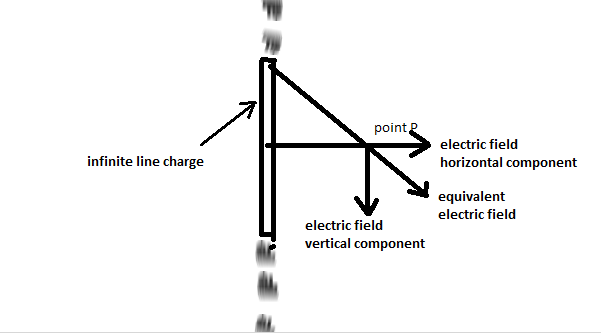
An infinite line charge produces a field of \[{\text{9}} \times {\text{1}}{{\text{0}}^4} N/ C \] at a distance of ${\text{2cm}}$. Calculate the linear charge density.
Answer
584.7k+ views
Hint: An infinite line charge is an arrangement of the charges in the form of a line which is extending to the infinity. The line charge is also producing a magnetic field like a current carrying wire of finite length. So we will approach this problem with the help of the formula for the magnetic field produced by an infinite line charge.
Complete step-by-step solution -

Now firstly we will write the given quantities in the problem,
Magnetic field produced = \[{\text{9}} \times {\text{1}}{{\text{0}}^4} N/ C \]
And the distance of a point from the infinite line charge where we are considering the effect of magnetic field=${\text{d = 2cm}}$$ = 0.02m$
So as we know the formula for the magnetic field produced by a infinite line charge is as follows,
${\text{E = }}\dfrac{\lambda }{{2\pi { \in _0}{\text{d}}}}$-----equation (1)
where $\lambda $=charge density
and ${\text{E}}$= electric field produced
and $d$=distance of the point from the infinite line charge
${ \in _0}$=permittivity of free space
Also we know that $\dfrac{1}{{4\pi { \in _0}}} = 9 \times {10^9}N{m^2}{C^{ - 2}}$
So, $\pi { \in _0} = \dfrac{1}{{4 \times 9 \times {{10}^9}}}$
Now we will be using this value in place of the combination of two terms $\pi $and $ \in $.
now from the equation (1) we can derive the equation for the charge density as follows
So, $\lambda = 2\pi { \in _0}{\text{d}} \times {\text{E}}$------equation (2)
Now on putting the values of the quantities from the given quantities in the equation (2)
$\lambda = 2 \times \dfrac{1}{{4 \times 9 \times {{10}^9}}} \times 0.02 \times {\text{9}} \times {\text{1}}{{\text{0}}^4}$
$\lambda = {10^{ - 7}}{C/ m}$
Hence now we have line charge density, $\lambda = {10^{ - 7}}{C/m}$ for the above given problem.
Note: Here we have seen the use of ${ \in _0}$which is called the vacuum permittivity or the permittivity of the free space. Other names of this quantity are electric constant or the distributed capacitance of the vacuum. It is an ideal physical constant. It is the value of the absolute dielectric permittivity of vacuum.
Complete step-by-step solution -

Now firstly we will write the given quantities in the problem,
Magnetic field produced = \[{\text{9}} \times {\text{1}}{{\text{0}}^4} N/ C \]
And the distance of a point from the infinite line charge where we are considering the effect of magnetic field=${\text{d = 2cm}}$$ = 0.02m$
So as we know the formula for the magnetic field produced by a infinite line charge is as follows,
${\text{E = }}\dfrac{\lambda }{{2\pi { \in _0}{\text{d}}}}$-----equation (1)
where $\lambda $=charge density
and ${\text{E}}$= electric field produced
and $d$=distance of the point from the infinite line charge
${ \in _0}$=permittivity of free space
Also we know that $\dfrac{1}{{4\pi { \in _0}}} = 9 \times {10^9}N{m^2}{C^{ - 2}}$
So, $\pi { \in _0} = \dfrac{1}{{4 \times 9 \times {{10}^9}}}$
Now we will be using this value in place of the combination of two terms $\pi $and $ \in $.
now from the equation (1) we can derive the equation for the charge density as follows
So, $\lambda = 2\pi { \in _0}{\text{d}} \times {\text{E}}$------equation (2)
Now on putting the values of the quantities from the given quantities in the equation (2)
$\lambda = 2 \times \dfrac{1}{{4 \times 9 \times {{10}^9}}} \times 0.02 \times {\text{9}} \times {\text{1}}{{\text{0}}^4}$
$\lambda = {10^{ - 7}}{C/ m}$
Hence now we have line charge density, $\lambda = {10^{ - 7}}{C/m}$ for the above given problem.
Note: Here we have seen the use of ${ \in _0}$which is called the vacuum permittivity or the permittivity of the free space. Other names of this quantity are electric constant or the distributed capacitance of the vacuum. It is an ideal physical constant. It is the value of the absolute dielectric permittivity of vacuum.
Recently Updated Pages
Master Class 12 Business Studies: Engaging Questions & Answers for Success

Master Class 12 Economics: Engaging Questions & Answers for Success

Master Class 12 English: Engaging Questions & Answers for Success

Master Class 12 Maths: Engaging Questions & Answers for Success

Master Class 12 Social Science: Engaging Questions & Answers for Success

Master Class 12 Chemistry: Engaging Questions & Answers for Success

Trending doubts
What are the major means of transport Explain each class 12 social science CBSE

Which are the Top 10 Largest Countries of the World?

Draw a labelled sketch of the human eye class 12 physics CBSE

How much time does it take to bleed after eating p class 12 biology CBSE

Explain sex determination in humans with line diag class 12 biology CBSE

Differentiate between homogeneous and heterogeneous class 12 chemistry CBSE




